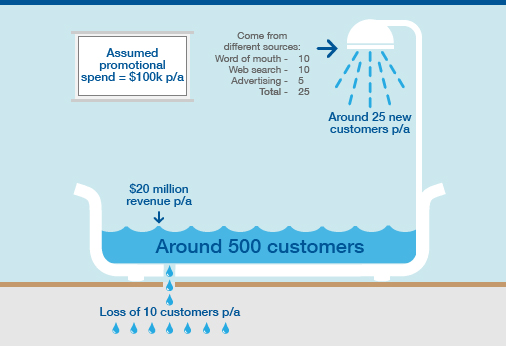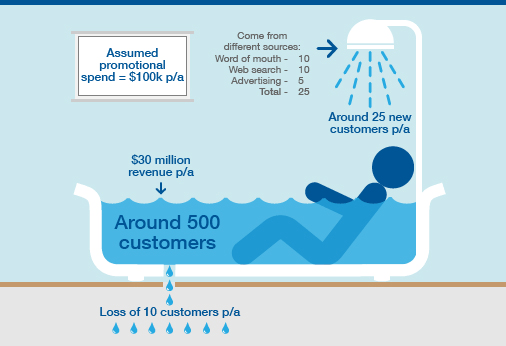Typically the number of customers that a business-to-business company deals with can easily be captured on a modest spreadsheet. 90% of business-to-business companies have less than 500 customers.
These customers can be regarded as water in the bathtub. Let us continue with our hypothetical business-to-business company that has around 500 live customers that it supplies over a year. The bathtub will receive some new customers each year, and these will flow in from various sources. In business-to-business markets this is often via a web search or recommendation. Some will arrive after seeing an advert or promotion.
There will be some inevitable loss from the bathtub possibly because customers no longer have a requirement for the product or they have found another supplier they consider to be more suitable. The water in the bath tub is in a sort of equilibrium, hopefully growing a little year on year.

A business-to-business company does not require a vast promotional budget to manage the water in the bathtub. Businesses-to-business brands often have marketing budgets of $100,000 to $200,000 per annum and many survive on much less.
This brings into question how we business-to-business marketers can increase the water in the bathtub? For most business-to-business companies, winning more new customers can be achieved by a tightly managed promotional campaign with messages that resonate. However, doubling or trebling the promotional spend may not make the tap run much faster. Most business-to-business companies address target customers in niches which contain relatively few potential buyers. Spending more money on broad-based marketing campaigns would mean that many of the promotions fall on stony ground. If the potential customers are in a niche, they are better prized out with highly selective promotional campaigns and these may not be that expensive. Firing with a rifle is usually more effective in business-to-business marketing than firing with a blunderbuss.
Direct marketing, trade fairs, and adverts in specific journals are the obvious marketing tools and much can be achieved within a modest budget (at least compared to consumer campaigns). In reality it is hard to justify expensive marketing campaigns in many business-to-business markets.
Building the loyalty of existing customers and winning more of their wallet is a much more efficient way of growing sales than seeking new customers (tweet this). This involves really getting to know existing customers. Indeed, if you get in the water with them, guess what, the water will rise straightaway. Did someone say eureka?



